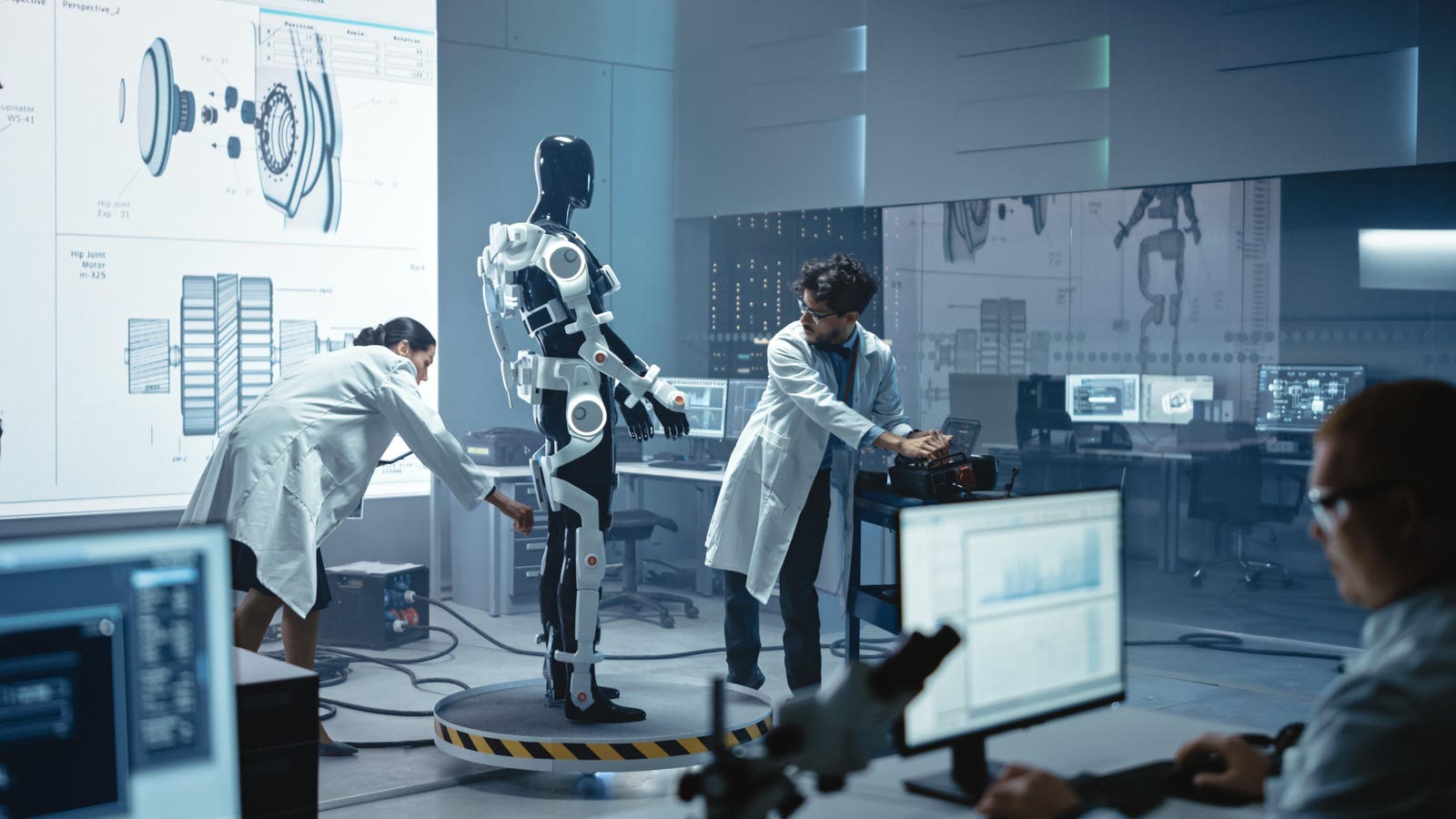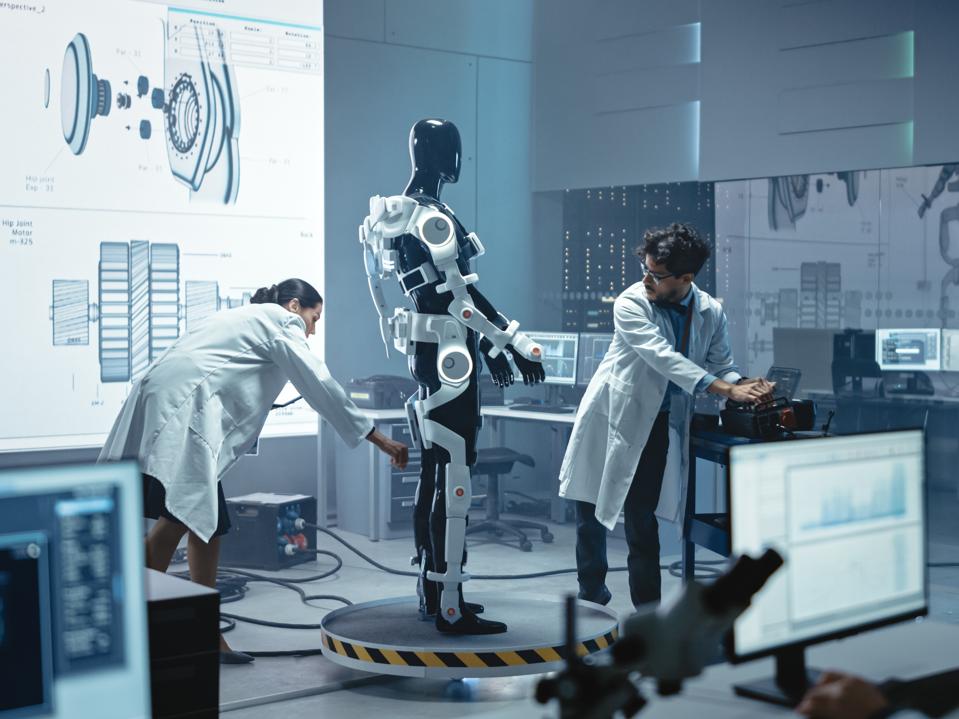AGI will be embedded into humanoid robots, which makes white-collar and blue-collar jobs a target … More
In today’s column, I examine the highly worrisome qualms expressed that the advent of artificial general intelligence (AGI) is likely to usurp white-collar jobs. The stated concern is that since AGI will be on par with human intellect, any job that relies principally on intellectual pursuits such as typical white-collar work will be taken over via the use of AGI. Employers will realize that rather than dealing with human white-collar workers, they can more readily get the job done via AGI. This, in turn, has led to a rising call that people should aim toward blue-collar jobs, doing so because (presumably) those forms of employment will not be undercut via AGI.
Sorry to say, that misses the bigger picture, namely that AGI when combined with humanoid robots is coming not only for white-collar jobs but also blue-collar jobs too. It is a proverbial double-whammy when it comes to the attainment of AGI.
Let’s talk about it.
This analysis of an innovative AI breakthrough is part of my ongoing Forbes column coverage on the latest in AI, including identifying and explaining various impactful AI complexities (see the link here).
Heading Toward AGI And ASI
First, some fundamentals are required to set the stage for this weighty discussion.
There is a great deal of research going on to further advance AI. The general goal is to either reach artificial general intelligence (AGI) or maybe even the outstretched possibility of achieving artificial superintelligence (ASI).
AGI is AI that is considered on par with human intellect and can seemingly match our intelligence. ASI is AI that has gone beyond human intellect and would be superior in many if not all feasible ways. The idea is that ASI would be able to run circles around humans by outthinking us at every turn. For more details on the nature of conventional AI versus AGI and ASI, see my analysis at the link here.
We have not yet attained AGI.
In fact, it is unknown as to whether we will reach AGI, or that maybe AGI will be achievable in decades or perhaps centuries from now. The AGI attainment dates that are floating around are wildly varying and wildly unsubstantiated by any credible evidence or ironclad logic. ASI is even more beyond the pale when it comes to where we are currently with conventional AI.
AGI Problem Only Half Seen
Before launching into the primary matter at hand in this discussion, let’s contemplate a famous quote attributed to Charles Kettering, a legendary inventor, who said, “A problem well-stated is a problem half-solved.”
I bring this up because those loud clamors right now about the assumption that AGI will replace white-collar workers are only seeing half of the problem. The problem as they see it is that since AGI is intellectually on par with humans, and since white-collar workers mainly use intellect in their work endeavors, AGI is going to be used in place of humans for white-collar work.
I will in a moment explain why that’s only half of the problem and there is a demonstrative need to more carefully and fully articulate the nature of the problem.
Will AGI Axiomatically Take White-Collar Jobs
On a related facet, the belief that AGI will axiomatically replace white-collar labor makes a number of other related key assumptions. I shall briefly explore those and then come back to why the problem itself is only half-baked.
The cost of using AGI for doing white-collar work will need to be presumably a better ROI choice over human workers. If not, then an employer would be wiser to stick with humans rather than employing AGI. There seems to often be an unstated belief that AGI is necessarily going to be a less costly route than employing humans.
We don’t know yet what the cost of using AGI will be.
It could be highly expensive. Indeed, some are worried that the world will divide into the AGI haves and AGI have-nots, partially due to the exorbitant cost that AGI might involve. If AGI is free to use, well, that would seem to be the nail in the coffin related to using human workers for the same capacity. Another angle is that AGI is relatively inexpensive in comparison to human labor. In that case, the use of AGI is likely to win over human labor usage.
But if the cost of AGI is nearer to the cost of human labor (all in), or more so, then employers would rationally need to weigh the use of one versus the other.
Note that when referring to the cost of human labor, there is more to that calculation than simply the dollar-hour labor rate per se. There are lots of other less apparent costs, such as the cost to manage human labor, the cost of dealing with HR-related issues, and many other factors that come into the weighty matter. Thus, an AGI versus human labor ROI will be more complex than it might seem at an initial glance. In addition, keep in mind that AGI would seemingly be readily switched on and off, and have other capacities that human labor would not equally tend to allow.
The Other Half Is Coming Too
Assume that by and large the advent of AGI will decimate the need for white-collar human labor. The refrain right now is that people should begin tilting toward blue-collar jobs as an alternative to white-collar jobs. This is a logical form of thinking in the sense that AGI as an intellectual mechanism would be unable to compete in jobs that involve hands-on work.
A plumber needs to come to your house and do hands-on work to fix your plumbing. This is a physicality that entails arriving at your physical home, physically bringing and using tools, and physically repairing your faulty home plumbing. A truck driver likewise needs to sit in the cab of a truck and drive the vehicle. These are physically based tasks.
There is no getting around the fact that these are hands-on activities.
Aha, yes, those are physical tasks, but that doesn’t necessarily mean that only human hands can perform them. The gradual emergence of humanoid robots will provide an alternative to human hands. A humanoid robot is a type of robot that is built to resemble a human in form and function. You’ve undoubtedly seen those types of robots in the many online video recordings showing them walking, jumping, grasping at objects, and so on.
A tremendous amount of active research and development is taking place to devise humanoid robots. They look comical right now. You watch those videos and laugh when the robot trips over a mere stick lying on the ground, something that a human would seldom trip over. You scoff when a robot tries to grasp a coffee cup and inadvertently spills most of the coffee. It all seems humorous and a silly pursuit.
Keep in mind that we are all observing the development process while it is still taking place. At some point, those guffaws of the humanoid robots will lessen. Humanoid robots will be as smooth and graceful as humans. This will continue to be honed. Eventually, humanoid robots will be less prone to physical errors that humans make. In a sense, the physicality of a humanoid robot will be on par with humans, if not better, due to its mechanical properties.
Do not discount the coming era of quite physically capable humanoid robots.
AGI And Humanoid Robots Pair Up
You might remember that in The Wonderful Wizard of Oz, the fictional character known as The Strawman lacked a brain.
Without seeming to anthropomorphize humanoid robots, the current situation is that those robots typically use a form of AI that is below the sophistication level of modern generative AI. That’s fine for now due to the need to first ensure that the physical movements of the robots get refined.
I have discussed that a said-to-be realm of Physical AI is going to be a huge breakthrough with incredible ramifications, see my analysis at the link here. The idea underlying Physical AI is that the AI of today is being uplifted by doing data training on the physical world. This also tends to include the use of World Models, consisting of broad constructions about how the physical world works, such as that we are bound to operate under conditions of gravity, and other physical laws of nature, see the link here.
The bottom line here is that there will be a close pairing of robust AI with humanoid robots.
Imagine what a humanoid robot can accomplish if it is paired with AGI.
I’ll break the suspense and point out that AGI paired with humanoid robots means that those robots readily enter the blue-collar worker realm. Suppose your plumbing needs fixing. No worries, a humanoid robot that encompasses AGI will be sent to your home. The AGI is astute enough to carry on conversations with you, and the AGI also fully operates the robot to undertake the plumbing tasks.
How did the AGI-paired humanoid robot get to your home?
Easy-peasy, it drove a car or truck to get there.
I’ve previously predicted that all the work on devising autonomous vehicles and self-driving cars will get shaken up once we have suitable humanoid robots devised. There won’t be a need for a vehicle to contain self-driving capabilities. A humanoid robot will simply sit in the driver’s seat and drive the vehicle. This is a much more open-ended solution than having to craft components that go into and onto a vehicle to enable self-driving. See my coverage at the link here.
Timing Is Notable
One of the reasons that many do not give much thought to the pairing of AGI with humanoid robots is that today’s humanoid robots seem extraordinarily rudimentary and incapable of performing physical dexterity tasks on par with human capabilities. Meanwhile, there is brazen talk that AGI is just around the corner.
AGI is said to be within our grasp.
Let’s give the timing considerations a bit of scrutiny.
There are three primary timing angles:
- Option 1: AGI first, then humanoid robots. AGI is attained before humanoid robots are sufficiently devised.
- Option 2: Humanoid robots first, then AGI. Humanoid robots are physically fluently adept before AGI is attained.
- Option 3: AGI and humanoid robots arrive about at the same time. AGI is attained and at the same time, it turns out that humanoid robots are fluently adept too, mainly by coincidence and not due to any cross-mixing.
A skeptic would insist that there is a fourth possibility, consisting of the possibility that we never achieve AGI and/or we fail to achieve sufficiently physically capable humanoid robots. I am going to reject that possibility. Perhaps I am overly optimistic, but it seems to me that we will eventually attain AGI, and we will eventually attain physically capable humanoid robots.
I shall next respectively consider each of the three genuinely reasonable possibilities.
Option 1: AGI First, Then Humanoid Robots
What if we manage to attain AGI before we manage to achieve physically fluent humanoid robots?
That’s just fine.
We would indubitably put AGI to work as a partner with humans in figuring out how we can push along the budding humanoid robot development process. It seems nearly obvious that with AGI’s capable assistance, we would overcome any bottlenecks and soon enough arrive at top-notch physically adept humanoid robots.
At that juncture, we would then toss AGI into the humanoid robots and have ourselves quite an amazing combination.
Option 2: Humanoid Robots First, Then AGI
Suppose that we devise very physically adept humanoid robots but have not yet arrived at AGI.
Are we in a pickle?
Nope.
We could use conventional advanced AI inside those humanoid robots. The combination would certainly be good enough for a wide variety of tasks. The odds are that we would need to be cautious about where such robots are utilized. Nonetheless, we would have essentially walking, talking, and productive humanoid robots.
If AGI never happens, oh well, we end up with pretty good humanoid robots. On the other hand, once we arrive at AGI, those humanoid robots will be stellar. It’s just a matter of time.
Option 3: AGI And Humanoid Robots At The Same Time
Let’s consider the potential of AGI and humanoid robots perchance being attained around the same time. Assume that this timing isn’t due to an outright cross-mixing with each other. They just so happen to advance on a similar timeline.
I tend to believe that’s the most likely of the three scenarios.
Here’s why.
First, despite all the hubris about AGI being within earshot, perhaps in the next year or two, which is a popular pronouncement by many AI luminaries, I tend to side with recent surveys of AI developers that put the date around the year 2040 (see my coverage at the link here). Some AI luminaires sneakily play with the definition of AGI in hopes of making their predictions come true sooner, akin to moving the goalposts to easily score points. For my coverage on Sam Altman’s efforts of moving the cheese regarding AGI attainment, see the link here.
Second, if you are willing to entertain the year 2040 as a potential date for achieving AGI, that’s about 15 years from now. In my estimation, the advancements being made in humanoid robots will readily progress such that by 2040 they will be very physically adept. Probably be sooner, but let’s go with the year 2040 for ease of contemplation.
In my view, we will likely have humanoid robots doing well enough that they will be put into use prior to arriving at AGI. The pinnacle of robust humanoid robots and the attainment of AGI will roughly coincide with each other.
Two peas in a pod.
Impact Of Enormous Consequences
In an upcoming column posting, I will examine the enormous consequences of having AGI paired with fully physically capable humanoid robots. As noted above, this will have a humongous impact on white-collar work and blue-collar work. There will be gargantuan economic impacts, societal impacts, cultural impacts, and so on.
Some final thoughts for now.
A single whammy is already being hotly debated. The debates currently tend to be preoccupied with the loss of white-collar jobs due to the attainment of AGI. A saving grace seems to be that at least blue-collar jobs are going to be around and thriving, even once AGI is attained. The world doesn’t seem overly gloomy if you can cling to the upbeat posture that blue-collar tasks remain intact.
The double whammy is a lot more to take in.
But the double whammy is the truth. The truth needs to be faced. If you are having doubts as a human about the future, just remember the famous words of Vince Lombardi: “Winners never quit, and quitters never win.”
Humankind can handle the double whammy.
Stay tuned for my upcoming coverage of what this entails.









